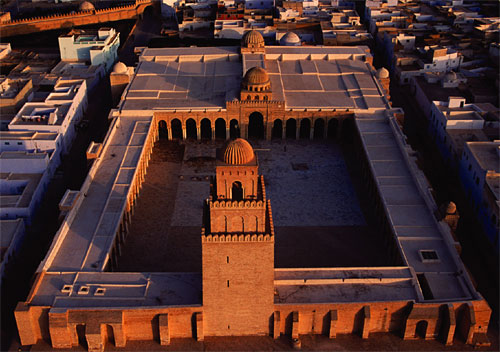One of the major architectural significance of the Arab invasion of North Africa was the construction of massive and often magnificent mosques constructed around military style courtyards along the court coast of the Mediterranean. In 670 CE, conquering general Sidi Okba constructed a Friday Mosque in what was becoming Kairouan in modern day Tunisia. A Friday Mosque is used for communal prayers on the Muslim holy day, Friday. Known as the Great Mosque of Kairouan, it is an early example of a hypostyle mosque that also reflects how pre-Islamic and eastern Islamic art and motifs were incorporated into the religious architecture of Islamic North Africa. The mosque contains a large prayer hall, a dome, an arcaded courtyard and three story tower believed to be the oldest in the world. Bordering the courtyard are the horseshoe shaped arches that are one of the characteristics of Islamic architecture, supported by Corinthian columns that trace their stylistic origin back to Ancient Greek temples.
In fact, many of the columns and stones forming the structure of the building were stolen from ancient Roman buildings in and around Kairouan. The interior of the prayer hall, however, is decorated with detailed painted and carved ornamentation of distinctly Islamic origin, including motifs based on designs from naturals world, such as acanthus, vine, and palms.
The dome is an architectural element borrowed from Roman and Byzantine architecture. The small windows of the dome above the mihrab space let natural light in. The stone dome is constructed of twenty-four ribs that each have a small corbel at their base.
The Great Mosque of Kairouan was a public
structure, set along roads that served a city with a vibrant commercial,
educational, and religious life. As such, it assumed the important function of
representing a cosmopolitan and urbane Kairouan, one of the first cities
organized under Muslim rule in North Africa. Even today, the Great Mosque of
Kairouan reflects the time and place in which it was built.
Sources:
Apelian, Colette. "The Great Mosque Of Kairouan." Khan Academy. Web
Glancey, Jonathan. Architecture. London: DK, 2006. Print


No comments:
Post a Comment